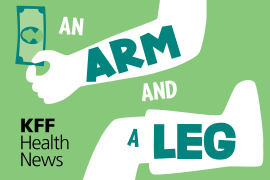Research Roundup: Safety-Net Hospitals Stack Up Well Against Others
Every week, KHN reporter Shefali S. Kulkarni compiles a selection of recently-released health policy studies and briefs.
Journal Of The American Medical Association: Association Of Emergency Department Length Of Stay With Safety-Net Status -- This study compares ER performance at safety-net hospitals (those with a disproportionate share of Medicaid and uninsured patients) to non-safety net hospitals to see if proposed pay-for-performance measures could have a negative impact. Researchers examined whether patients were admitted to the hospital within eight hours of showing up in the ER or if they were be discharged, transferred or moved to observation within four hours of coming to the ER. Using national hospital data, researchers found "compliance with proposed ER length-of-stay measures for admitted, discharged, transferred, and observed patients to not differ between safety-net and non-safety-net hospitals" (Fee et. al., 2/1).
Government Accountability Office: CMS Should Improve The Accuracy Of Risk Score Adjustments For Diagnostic Coding Practices – This GAO report – requested by four Democratic congressmen – examines how the Centers for Medicare and Medicaid Services "pays plans in Medicare Advantage (MA)—the private plan alternative to Medicare fee-for-service (FFS)—a predetermined amount per beneficiary adjusted for health status. To make this adjustment, CMS calculates a risk score, a relative measure of expected health care costs, for each beneficiary. ... Policymakers raised concerns that differences in diagnostic coding between MA plans and Medicare FFS could lead to inappropriately high MA risk scores and payments to MA plans." GAO found that "before CMS's adjustment, 2010 MA beneficiary risk scores were at least 4.8 percent and perhaps as much as 7.1 percent higher than they likely would have been if the same beneficiaries had been continuously enrolled in [fee-for-service plans]," and recommends that CMS use more updated beneficiary data when calculating their risk score adjustment (1/12).
Institute of Medicine: Living Well With Chronic Illness: A Call For Public Action -- This major report examines the overwhelming prevalence of chronic disease in the U.S. The authors recommend "that a variety of illnesses be selected for public health action based on a planning process that emphasizes the inclusion of chronic illnesses with cross-cutting clinical, functional and social implications that impact the individuals who live with them," and also write: "Given the economic burden of chronic diseases to the United States, the CDC should support expanded use of new and emerging economic methods, such as cost-effectiveness techniques, in making policy decisions that promote living well with chronic illness" (Bell et. al., 1/31).
Journal Of Health Services Research: The Effectiveness Of Implementing An Electronic Health Record On Diabetes Care Outcomes -- Researchers analyzed data on patients who were 40 years or older and had at least two diabetes-related visits within a year to a primary care physician. The patients who visited doctors who had adopted an electronic medical record system (which reminded them of recommended care procedures) had significantly more improvements in blood pressure readings, were less likely to smoke and more likely to take aspirin to prevent heart disease than patients of doctors without EHRs. However, the study did not show any improvements in those patients’ blood sugar or cholesterol levels. (Herrin et al., 1/17).
The Kaiser Family Foundation: A Guide To The Supreme Court’s Review Of The 2010 Health Care Reform Law -- This issue brief looks at the background and issues surrounding two major provisions of the federal health law that are at the heart of the case that the Supreme Court will hear in March: the individual mandate to purchase health insurance or pay a fine and the expansion of the Medicaid program to cover "all people under age 65 with household incomes at or below 133%" of the federal poverty level. The brief reviews the Anti-Injunction Act and the Commerce Clause as they might apply to the decisions of the court (Musumeci, 2/1).
Related resource page from KHN: The Supreme Court Decides: Health Law At The High Court
This is part of the Morning Briefing, a summary of health policy coverage from major news organizations. Sign up for an email subscription.





